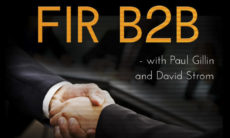Content Overload
We’re almost 10 years into one of the latest and hottest marketing trends – Content Marketing – and most B2B firms are churning out lots of it. But like most good things, such as Texas BBQ or Chicago deep dish pizza, we tend to overdo it! As a result we’re into the next inevitable phase of content marketing – content overload. First, let me give full credit to my friend Joe Pulizzi, Content Marketing Institute founder, who in eight years has brought content marketing strategy to the forefront of CMO’s campaign plans. We share two things in common – a belief in content marketing, and also are frustrated fans of the Cleveland Browns – he even wears orange! But I digress.
Another long time friend, Bob Bly, was the first who wrote extensively about content marketing in his 2005 White Paper Marketing Handbook, which is still available on Amazon. Bob informs me that an update version will be published later this year and is appropriately titled The Content Marketing Handbook. For more insightful information from Bob, go to www.bly.com/reports. You will learn a lot from Bob, and in my opinion, he is the premier B2B copywriter.
With all this content trying to connect with B2B buyers, the question marketers need to know is how do buyers process and filter through the mountain of information to determine what product and/or service meets their needs, and whom to buy from? It’s not an easy assignment for buyers to sort through all the content now available to find the most informative and creditable information to advance their buying process. They tend to accomplish the initial phases of their process in anonymity, as we’ve all read that as much as 60% of the buying process is done before they contact the selected vendors. Now that’s a scary thought for an old time lead generation guy!
Conversely, how then do sellers effectively grab the attention and engage these buyers with content? It’s not good enough anymore to just push content out there, as it will be lost in the content clutter. What is required to connect with buyers is a more sophisticated content marketing strategy and plan.
In part one of a two-part post, I will outline the 5 Principals to develop and market your content.
5 Proven Principals of Content Development and Marketing
When faced with a blank campaign planning template, there are five proven principals that marketers and their agencies should consider in developing both the content that will break through and engage buyers, and will also help advance the buyer’s buying process. In logical order they are:
1. Alignment to the buying stage and buyer’s needs
Content works best when selling complex B2B products and/or services, as there are multiple buying steps and different needs of each individual of the buying team. Let’s assume that six major buying stages are present in a complex sale, even though for some products/services there are more.
- Initial research to identify the solution(s) and vendors to meet the need
- Paring down the options to a limited number of vendors – typically three
- Discussions, demos, and due diligence with the selected vendors
- Proposals requested, received, and evaluated from vendors
- Agreement of the buying team to select one vendor
- Negotiation and purchase
Content is most impactful in the first three buying stages. Your job is to develop content that matches the logical interests and needs of the buyers at these first three stages. This job is made even more difficult as there are typically three types of buyers with different informational needs and objectives. The three most common are the manager who’s group will use the product/service (decision maker), purchasing function (economic buyer), and end users (influencers).
If one matches each type of Buyer (Decision Maker, Economic Buyer, Influencers) which each type of Buying stage (Research, Paring Down, Due Diligence), the result is a nine box grid that needs to be filled in with relevant content. Much like progressive profiling of an individual in the lead process, this is progressive contenting (did I just coin a new phrase?) as the buying process moves from Research, to Paring Down, to Due Diligence. In the research stages, topics that relate to the general nature of the problem/solution are most engaging. This type of content can also do double duty and position the company as a thought-leader.
As the buyer moves closer to the buying decision, content that is more specific to how your product/service solves the problem is best. At this stage, more “selling” content is appropriate and well received by the buyers. In other words, don’t try to sell too fast and pace the content in parallel with the buyer’s interest stage. Another way to view it is, as the buying stages move forward, the content also needs to move from educational, to instructive, to proof.
This content development, while challenging, will result in the buyer progressively becoming more convinced that you have the right product/service for their needs. It also will likely uncover the need to develop more content, but the rewards will be more sales
2. Credibility
How creditable is your content? I don’t mean how good or informative the content is, but rather is it believable? When I read white papers, e-books, view videos, and participate in webinars, one of the first things I check is who the author or speaker is, and from what company do they work? On a scale, I give a low score to content from the vendor’s VP of Sales vs. a high score when a third party expert is the source. The more creditable the source is, the more creditable the information is in the eyes of the potential buyer!
Here’s a brief story to exemplify my point. Several years ago, I was referred to an individual in Phoenix who had just sold his firm to GE Capital for $800 million – now that’s a lot of money. He was starting a new firm, and needed a lead generation consultant. An appointment was made, and when we began to talk it was clear that he was not particularly impressed with my expertise until I gave him a copy of my book. The very first thing he did was look at the spine to see who published it, and fortunately it was McGraw-Hill. His attitude changed dramatically, and even though I didn’t get the job (for other reasons), it was a classic example of how third party credibility impacts perception.
I realize that third party experts might challenge your budget, but if you can afford it, use independent sources for the content creation in the Research buying stage or at least provide quotes and examples from these individuals that are on point. The identical content from an independent and creditable source is far more impactful and believable than from anyone internal, even the President.
If you do employ an independent expert, negotiate for multiple uses of their content for extended mileage. As an example, a webinar can translate into a slide deck sent after the webinar, a white paper, or multiple replays of the webinar. In part 2, the 4th Proven Principal will discuss how variety increases results or in other words, multiple touches in multiple media works best when generating and qualifying leads.
Principals 3, 4, and 5 to follow in May!






